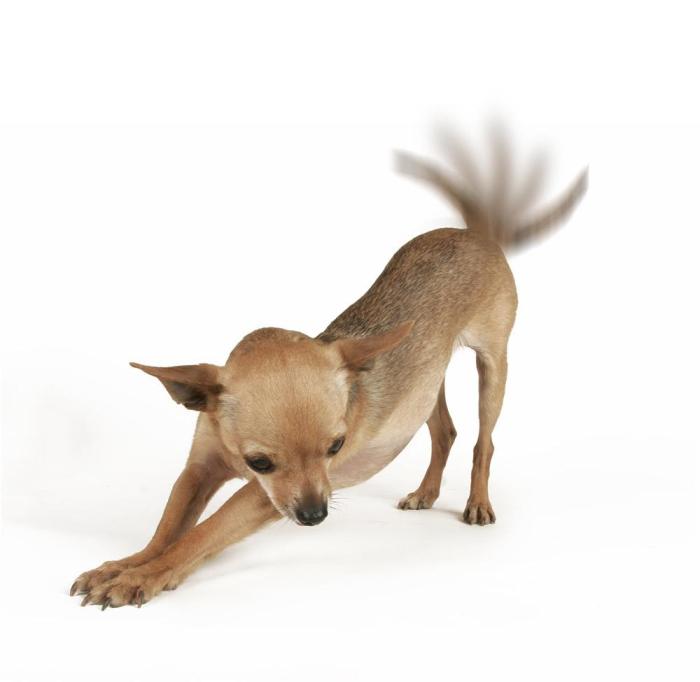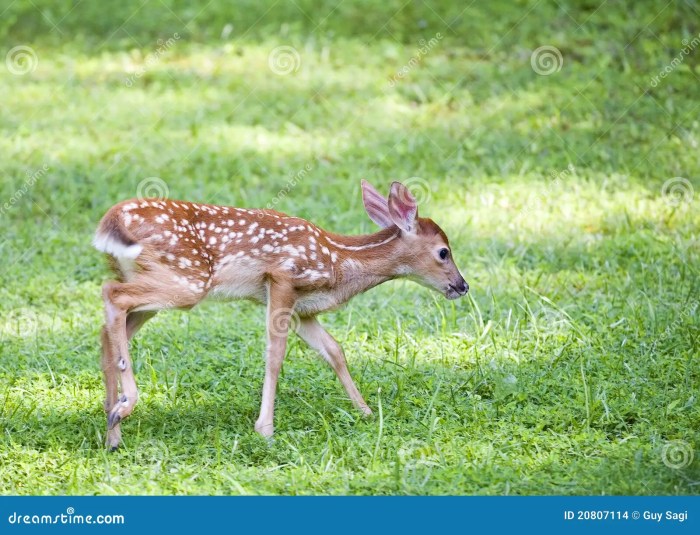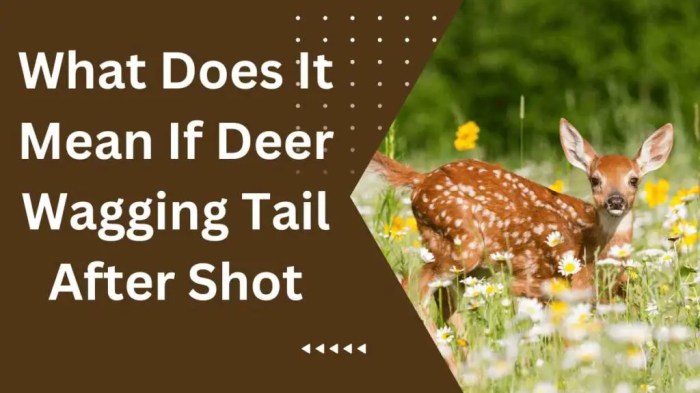Deer wagging tail after shot – Deer wagging their tails after being shot is a perplexing behavior that has puzzled hunters and biologists alike. This article delves into the physiological, neurological, and evolutionary factors that contribute to this unusual response, exploring its implications for hunting and conservation.
When a deer is shot, its body undergoes a series of physiological responses that can trigger tail movement. These responses include the release of adrenaline, which increases heart rate and blood pressure, and the activation of the sympathetic nervous system, which prepares the body for a fight-or-flight response.
Deer Behavior

When a deer is shot, its natural instinct is to flee the scene of danger. However, in some cases, deer may exhibit unusual behaviors after being shot, such as wagging their tails.
The reasons why deer wag their tails after being shot are not fully understood. However, there are a few possible explanations. One possibility is that the deer is experiencing a muscle spasm or reflex that causes its tail to wag.
Another possibility is that the deer is trying to communicate something to other deer in the area, such as a warning or a distress call.
Factors Influencing Tail Wagging
Several factors may influence whether or not a deer will wag its tail after being shot. These factors include the location of the shot, the severity of the injury, and the deer’s individual personality.
- Location of the shot:A deer that is shot in the hindquarters is more likely to wag its tail than a deer that is shot in the head or chest.
- Severity of the injury:A deer that is severely injured is less likely to wag its tail than a deer that is only slightly injured.
- Deer’s individual personality:Some deer are more likely to wag their tails than others, regardless of the location or severity of the injury.
Physiological Responses

When deer are shot, they experience a range of physiological responses that can contribute to the wagging of their tail. These responses include:
Adrenaline Release
When a deer is shot, its body releases a surge of adrenaline. This hormone triggers the “fight or flight” response, which prepares the deer to either defend itself or flee from danger. The release of adrenaline can cause the deer’s heart rate and breathing to increase, and its muscles to tense up.
This can lead to the deer’s tail wagging as it tries to balance itself and prepare for action.
Muscle Spasms
The release of adrenaline can also cause muscle spasms in the deer’s tail. These spasms can be involuntary and can contribute to the wagging of the tail. The spasms may also be caused by the deer’s attempts to move or reposition itself after being shot.
Nerve Damage
In some cases, a shot may damage the nerves in the deer’s tail. This damage can lead to paralysis or weakness in the tail, which can cause the tail to wag uncontrollably. Nerve damage can also cause pain, which may make the deer wag its tail as a way of expressing discomfort.
Neurological Mechanisms

The neurological mechanisms that control tail movement in deer involve the central nervous system, which includes the brain and spinal cord, as well as the peripheral nervous system, which consists of nerves that extend from the central nervous system to the rest of the body.The
brain, particularly the cerebellum, plays a crucial role in coordinating and regulating muscle movements, including tail movements. The cerebellum receives sensory information from the spinal cord and other parts of the nervous system and uses this information to fine-tune and adjust muscle movements, ensuring smooth and coordinated actions.The
spinal cord serves as a conduit for nerve impulses traveling between the brain and the rest of the body. It contains motor neurons that transmit signals from the brain to the muscles, causing them to contract and relax. In the case of tail movement, motor neurons in the spinal cord transmit signals to the muscles of the tail, resulting in the characteristic wagging motion.
Peripheral Nervous System
The peripheral nervous system also plays a role in tail movement. Sensory neurons in the tail transmit information about the tail’s position and movement to the spinal cord and brain. This sensory feedback is essential for the brain to make appropriate adjustments to the motor commands sent to the tail muscles.
Evolutionary Significance: Deer Wagging Tail After Shot

The tail wagging behavior in deer after being shot is believed to have evolved as a survival mechanism. This behavior may have helped deer to escape predators or to communicate their distress to other members of the herd.
When a deer is shot, the sudden pain and shock may cause it to involuntarily wag its tail. This wagging motion may startle or confuse predators, giving the deer a chance to escape. Additionally, the tail wagging may produce a sound that attracts other deer, alerting them to the danger and allowing them to flee as well.
Predator Avoidance
Tail wagging in deer after being shot may have evolved as a way to startle or confuse predators. The sudden and unexpected movement of the tail may distract the predator, giving the deer a chance to escape. This behavior may have been particularly advantageous in situations where the deer was caught in the open and had limited options for escape.
The peculiar sight of a deer wagging its tail after being shot is said to be a sign of respect or gratitude towards the hunter. This behavior, which has been observed in various deer species, has sparked curiosity among scientists and hunters alike.
While the exact reason for this tail-wagging remains unknown, some theories suggest that it may be a way for the deer to communicate its surrender or acceptance of its fate. Interestingly, this phenomenon has also been linked to the Pillars of Adam and Eve , two rock formations in Namibia that are said to resemble the biblical figures of Adam and Eve.
The tail-wagging of the deer is believed to be a sign of respect to these pillars, which are considered sacred by the local Himba tribe.
Communication with Herd Members
Tail wagging in deer after being shot may also have evolved as a way to communicate distress to other members of the herd. The tail wagging may produce a sound that attracts other deer, alerting them to the danger and allowing them to flee as well.
This behavior may have been particularly important for young deer, which are more vulnerable to predators and may rely on the protection of the herd for survival.
Hunting Implications

The tail-wagging behavior in deer after being shot has significant implications for hunting practices. Hunters often rely on observing the deer’s behavior to determine the effectiveness of their shot. However, the wagging tail can be misleading, indicating a hit even when the deer is not fatally wounded.
Ethical Implications
The ethical implications of hunting deer that exhibit tail-wagging behavior are complex. On the one hand, it is important to minimize animal suffering and ensure a clean kill. Shooting a deer that is not fatally wounded can result in prolonged pain and distress.
On the other hand, some hunters argue that tail-wagging behavior is a natural reflex and not necessarily an indication of pain.Ultimately, the decision of whether or not to shoot a deer that is exhibiting tail-wagging behavior is a personal one.
Hunters should carefully consider the ethical implications and weigh the potential for animal suffering against the desire for a successful hunt.
Conservation Considerations

The tail-wagging behavior of deer after being shot has significant conservation implications. Understanding this behavior can help inform management practices and ensure the sustainability of deer populations and their habitats.
One key implication is that the behavior may indicate that deer are experiencing pain or distress. This suggests that hunting practices should prioritize minimizing suffering and ensuring a humane harvest. Hunters should aim for clean, ethical shots that result in a quick and painless death.
Impact on Deer Populations
- The tail-wagging behavior may provide a clue to the effectiveness of hunting practices. If a high proportion of harvested deer exhibit this behavior, it could indicate that hunting methods are causing unnecessary suffering or that deer populations are under excessive pressure.
- Monitoring the prevalence of tail-wagging can help wildlife managers assess the impact of hunting on deer populations and adjust regulations accordingly.
Impact on Habitats, Deer wagging tail after shot
- Deer are important herbivores that play a crucial role in shaping their habitats. Their feeding behavior can influence plant communities and ecosystem dynamics.
- If deer populations are reduced or their behavior is altered due to hunting practices, it could have cascading effects on the entire ecosystem.
Key Questions Answered
Why do deer wag their tails after being shot?
Deer wag their tails after being shot due to a combination of physiological and neurological responses triggered by the stress and pain of being injured.
What are the implications of deer wagging their tails after being shot for hunting?
Deer wagging their tails after being shot can indicate that the animal is still alive and may pose a safety risk to hunters. It is important to approach such deer with caution and ensure they are humanely dispatched.
What are the conservation implications of deer wagging their tails after being shot?
Deer wagging their tails after being shot can provide valuable information for researchers studying deer behavior and population dynamics. This behavior can help identify areas of high hunting pressure and inform management strategies aimed at protecting deer populations.